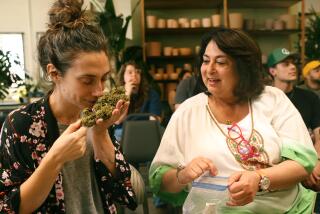CABBAGE : Cabbage Family Has Seven Attractive Members : Vegetables: Cole crops flourish between now and spring. They can be part of garden through seeds or transplants.
There are at least seven good reasons to plant a fall vegetable garden: cabbage, broccoli, cauliflower, Brussels sprouts, kohlrabi, collards and kale.
These cool-weather cole crops are members of the cabbage family (“cole” comes from caulis, the Latin name for cabbage). Crisp and crunchy, these vegetables flourish from now to early spring.
Although commonly found at markets, many don’t arrive fresh, and there are varieties with uncommonly good taste that only the home gardener can grow. Back-yard cabbage, for example, tastes remarkably sweeter.
Below is a rundown of the cole crops and the best varieties of each for Southern California gardens. Cabbage
Cabbage has been around as a cultivated crop for more than 2,000 years. An extremely adaptable vegetable, it thrives in gardens throughout most of the world. Seed catalogues in the United States alone list an astronomical 500 varieties.
Good green cabbage includes Early Jersey Wakefield, Emerald Cross Hybrid, Copenhagen Market, Stonehead Hybrid and Early Flat Dutch.
Red cabbage adds color to the garden as well as to the salad bowl. Good red cabbage choices include Ruby Ball Hybrid, Ruby Perfection Hybrid and Scarlet O’Hara Hybrid.
Savoy cabbages have crinkled foliage and the heads never become really hard. Many gardeners and gourmets consider savoy cabbage to have a sweeter, more delicate flavor than other cabbages. Savoy Ace, Savoy King and Early Curly Hybrid are superior savoy cabbages. Broccoli
Although broccoli was a prized addition to Roman gardens, it wasn’t until the 1920s that it was introduced to this country. California leads the nation in broccoli production.
Broccoli transplants should be spaced 18 inches apart, and the central heads should be harvested when the buds are small and tight, before they open into tiny yellow flowers.
Green Comet, Premium Corp Hybrid, Di Cicco, Bonanza Hybrid and Green Goliath are a quintet of winning broccoli varieties. In addition, Romanesco is an unusual Italian broccoli with a head that resembles a clump of individual swirls of light green sea coral and features a sweet, delicate flavor. Cauliflower
Referred to by gourmets as the “prince of the cole crops,” cauliflower is prized in this country for its pristine white heads. To get those pure white heads you have to blanch them: After the heads begin to form, tie the leaves over the heads to prevent exposure to the sun. When the heads are exposed to the sun, they turn yellow.
Like broccoli, cauliflower plants should be spaced 18 inches apart. Harvest cauliflower when the heads are tight and smooth.
Early Snowball A, Snow Crown Hybrid and Snow King Hybrid are a trio of top cauliflower choices. If you like the unusual, Purple Head Improved is a unique type with a dramatic purple head that turns green when cooked; it requires no blanching. Brussels Sprouts
Brussels sprouts are produced along the stalks of large, unusual looking plants. The sprouts, similar to tiny cabbage heads, develop from the bottom of the stalk upwards.
It is not unusual for each plant to produce 100 or more sprouts. Because of the large plant size, Brussels sprouts transplants should be spaced two feet apart. Jade Cross Hybrid, Jade Cross E Hybrid and Oliver Hybrid all produce well in the Southland. Kohlrabi
This unusual looking member of the cole family is grown for its bulbs, which are produced on the stems above the ground level. Kohlrabi is not a popular vegetable among home gardeners, but it should be. It is fine table fare whether eaten raw or cooked and is extremely easy to grow.
Kohlrabi is seldom available as a transplant. It is the most rapid of the cole crops to mature, reaching the harvest stage about 50 days after the seed is sown. Follow the directions on the seed packet for correct spacing. Grand Duke Hybrid is by far the best kohlrabi variety. Collards
Collards have long been a favorite vegetable in the South and are gaining popularity in gardens throughout the country. Rich in vitamins and with few calories, the cooked leaves taste somewhat like cabbage, but have a stronger mustard flavor.
Collard transplants should be spaced 15 inches apart. Harvest leaves as you need them and let the rest of the plant continue to grow. Choose either Georgia or Vates; both grow well here. Kale
Probably the least well-known of the cole crops, kale is unusually rich in calcium and other minerals. The plants make attractive landscaping items, and nurseries will often feature different varieties of ornamental kale grown for garden display.
They are beautiful plants, covering a range of pastel colors. Keep in mind, however, that ornamental kale varieties are not primarily designed for table fare. While most are edible, they are not nearly as succulent as those varieties bred for eating. Dwarf Blue Curled Vates is the best edible type for Southern California.
Full sun and a rich, porous soil are necessary for cole crops. Lots of compost, redwood shavings or other organic matter should be spaded into the soil. All cole crops are heavy feeders and need a complete fertilizer. Water deeply and allow soil to settle a few days before planting.
Seed packet directions should be adhered to when sowing seeds. Transplants should be buried a little deeper to encourage sturdy stems.
Because the cole crops like water, they should be irrigated deeply between rains. Liquid fertilizer applied every three weeks will produce significantly bigger crops.
Only cabbage worms are a serious problem during the cool months, but they can be easily controlled with a biological spray, that contains Bacillus thuringiensis. Products such as Dipel, Thuricide and Attack all contain this control.
Seeds or transplants for many of the varieties listed here should be available at local nurseries. Seeds for others may be ordered by mail from Burpee Seeds, Warminster, Pa. 18974. They offer a free catalogue.
GARDENER’S CHECKLIST
For dedicated gardeners, here are suggestions from the California Assn. of Nurserymen on what to do in the garden this week:
Keep fertilizing your lawn on a regular basis. This will help keep it greener longer into the cooler season.
Repot older root-bound cacti and succulents. Look for roots peeking out of the drain holes.
Look around this fall at what trees are changing leaf color and pick your favorite to plant for a color show of your own next year.
As the leaves fall off your deciduous trees, keep them picked up. They harbor diseases, and insects love to hide in the decaying foliage.






